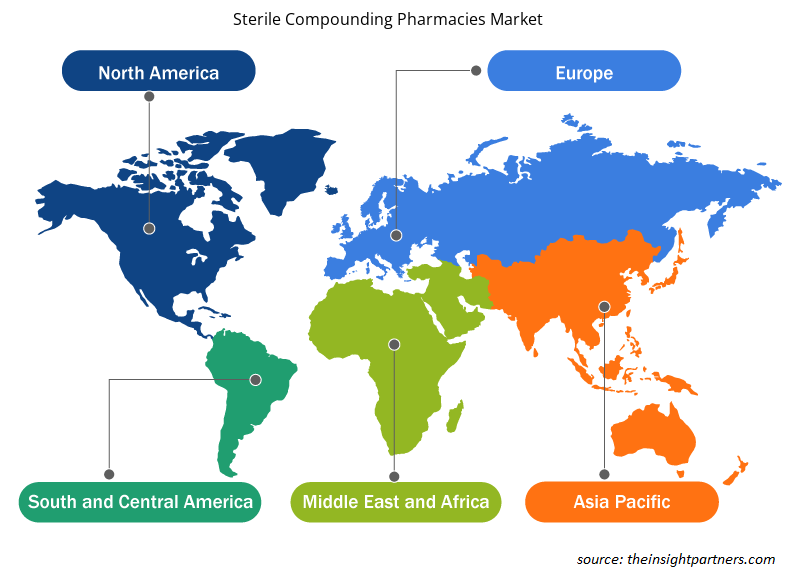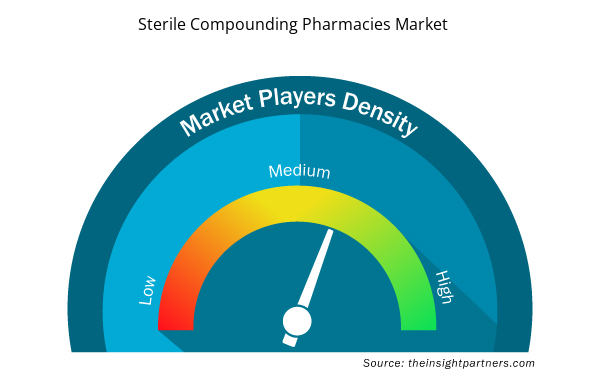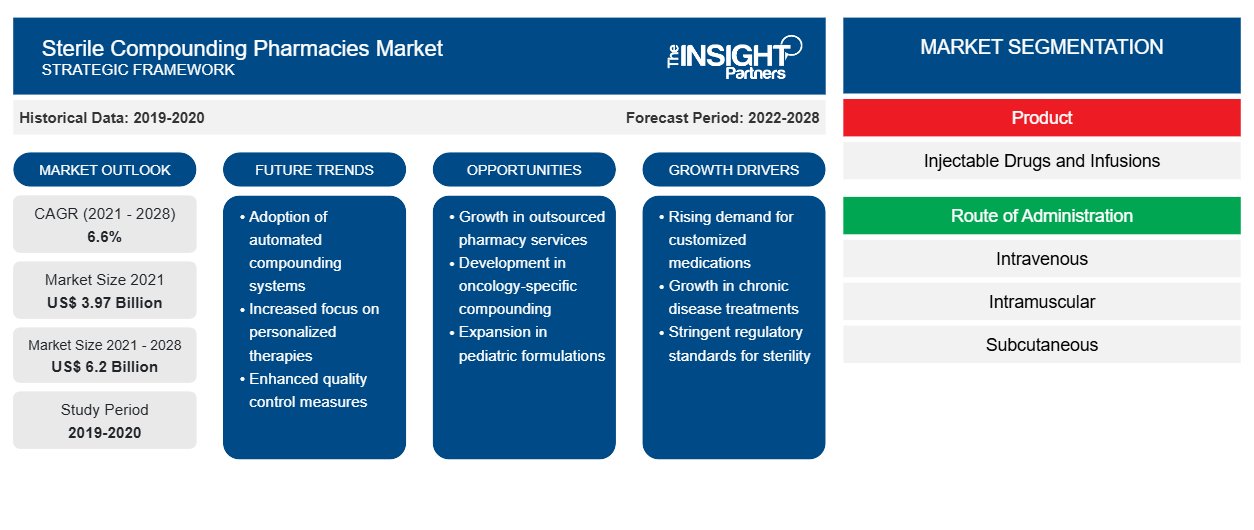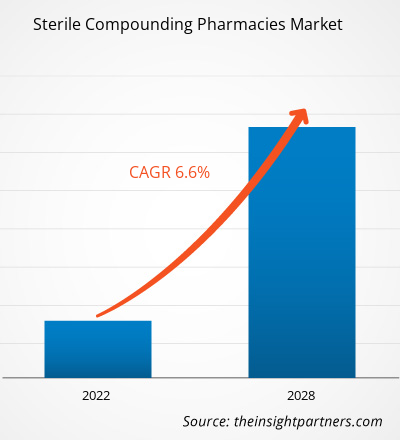[Forschungsbericht] Der Markt für sterile Rezepturarzneimittel wird voraussichtlich von 3.968,70 Millionen US-Dollar im Jahr 2021 auf 6.198,59 Millionen US-Dollar im Jahr 2028 anwachsen; von 2021 bis 2028 wird ein durchschnittliches jährliches Wachstum von 6,6 % erwartet.CAGR of 6.6% from 2021 to 2028.
Faktoren wie die zunehmende Nutzung personalisierter Medikamente und die Vorteile der sterilen Rezepturherstellung vor Ort treiben das Marktwachstum an. Produktrückrufe und strenge regulatorische Anforderungen behindern jedoch das Marktwachstum. Andererseits würde die Entwicklung zentralisierter oder regionaler Rezepturzentren für maßgeschneiderte Rezepturen im Prognosezeitraum lukrative Möglichkeiten für Marktwachstum schaffen.
Nordamerika wird seine Vorherrschaft auf dem Markt für sterile Rezepturen in den Jahren 2021–2028 voraussichtlich beibehalten. Die USA halten den größten Marktanteil in Nordamerika und dieser Trend wird sich im Prognosezeitraum voraussichtlich fortsetzen. Dies ist in erster Linie auf die steigenden Arzneimittelausgaben und die gut ausgebaute Gesundheitsinfrastruktur zurückzuführen. So hat die Food and Drug Administration (FDA) beispielsweise 503B benannt (zur Information: 503B wird als Outsourcing-Einrichtung bezeichnet und manchmal auch als 503B-Apotheken bezeichnet. Sie werden von der FDA streng überwacht, was ein neues Niveau der Patientenversorgung und -sicherheit schafft). Außerdem lagern fast 75 % der Krankenhäuser in den USA die Herstellung steriler Rezepturen an 503B-Einrichtungen aus, um Stabilität zu gewährleisten, Medikamentenknappheit zu bewältigen, eine gebrauchsfertige Form des Medikaments zu erhalten und die Haltbarkeit zu verlängern. Darüber hinaus wird erwartet, dass die steigende Zahl geriatrischer Patienten und die zunehmende Verwendung maßgeschneiderter Rezepturen anstelle kommerzieller Produkte das Wachstum des US- Marktes für sterile Rezepturen in den kommenden Jahren vorantreiben werden.
Passen Sie diesen Bericht Ihren Anforderungen an
Sie erhalten kostenlos individuelle Anpassungen an jedem Bericht, einschließlich Teilen dieses Berichts oder einer Analyse auf Länderebene, eines Excel-Datenpakets sowie tolle Angebote und Rabatte für Start-ups und Universitäten.
- Holen Sie sich die wichtigsten Markttrends aus diesem Bericht.Dieses KOSTENLOSE Beispiel umfasst eine Datenanalyse von Markttrends bis hin zu Schätzungen und Prognosen.
Markteinblicke
Vorteile der sterilen Herstellung vor Ort treiben das Marktwachstum an
Die Herstellung und Sterilisation vor Ort kann bei einer intravenösen Lösung, die an die Bedürfnisse des Patienten angepasst werden soll, von entscheidender Bedeutung sein. Die Herstellung vor Ort ermöglicht die Verabreichung des aktiven pharmazeutischen Wirkstoffs (API) an menschliche Probanden in den Anfangsphasen der frühen klinischen Arzneimittelentwicklung. Die sterile, extemporäre Herstellung bietet eine flexible Alternative zur kostspieligen, langwierigen Entwicklung parenteraler Prüfpräparate, die nach den Good Manufacturing (GMP)-Standards entwickelt wurden. Normalerweise werden parenteral verabreichte API für klinische Studien unter GMP-Bedingungen hergestellt. Dies reduziert potenziell die Zeit, die für die Herstellung eines fertigen Produkts für eine bestimmte Dosierung erforderlich ist.parenteral investigational products designed by the Good Manufacturing (GMP) standards. Typically, parenterally administered API for clinical studies are manufactured under GMP conditions. This potentially reduces the time required for producing a finished product needed for specific dosing.
Darüber hinaus gelingt das Zusammenstellen und Filtern einer Formulierung zu einer sterilen intravenösen Lösung durch eine enge Zusammenarbeit mit dem Pharmasponsor und den Apothekern vor Ort, wo Sterilitätstests effizient durchgeführt werden können.
Die sterile Rezepturherstellung vor Ort hat auf dem Weltmarkt stark an Bedeutung gewonnen und ist einer der einflussreichsten Faktoren für das Marktwachstum. Dies liegt daran, dass sich Apotheker bei der sterilen Rezepturherstellung stärker auf die neuesten Forschungsaktivitäten, innovative Techniken, Qualitätskontrollregeln und die Beschaffung der besten Inhaltsstoffe zur Erfüllung der Patientenbedürfnisse konzentrieren. So gab die National Association of Boards of Pharmacy (NABP) bekannt, dass sie von der Food and Drug Administration (FDA) Mittel für die Entwicklung eines Datenaustauschsystems erhalten hat, um die Aufsicht über Apotheken, die sterile Rezepturen herstellen, zu verbessern. Dieses neue System soll dabei helfen, Informationen zur sterilen Rezepturherstellung in den USA zu sammeln, zu verwalten und auszutauschen. Das Projekt zielt auch darauf ab, das Verletzungsrisiko zu verringern und Patienten vor Arzneimitteln zu schützen, die unsachgemäß hergestellt wurden.NABP) announced receiving funding from the Food and Drug Administration (FDA) to develop a data-sharing system to improve oversight of sterile compounding pharmacies. This new system is expected to assist in collecting, managing, and sharing information related to sterile compounding in the US. The project also aims to reduce the risk of injury, favoring patients from drug products that have been improperly compounded.
Produktbasierte Erkenntnisse
Basierend auf dem Produkt ist der Markt für sterile Compounding-Apotheken in injizierbare Medikamente und Infusionen unterteilt. Das Segment der injizierbaren Medikamente wird zwischen 2021 und 2028 einen größeren Marktanteil ausmachen. Injizierbare Medikamente gehören aufgrund ihrer schnelleren Wirkungsweise zu den bevorzugten sterilen Compounding-Produkten. Um nachteilige Auswirkungen auf die Patienten zu vermeiden, werden zusammengesetzte injizierbare Medikamente (definiert als Medikamente, die in einer Praxis verdünnt, gemischt, rekonstituiert und zubereitet werden) in einer Umgebung zusammengesetzt, in der geeignete Sicherheitsvorkehrungen gegen die Ausbreitung von Krankheiten getroffen werden und die Komponenten zusammengesetzter Medikamente die geeignete Stärke und Zusammensetzung aufweisen. Marktteilnehmer verfolgen organische und anorganische Wachstumsstrategien für das Marktwachstum. So kündigte QuVa Pharma, Inc. im September 2019 eine erhebliche Kapazitätssteigerung für zusammengesetzte sterile injizierbare Präparate an.
Regionale Einblicke in den Markt für sterile Compounding-Apotheken
Die regionalen Trends und Faktoren, die den Markt für sterile Rezepturen im Prognosezeitraum beeinflussen, wurden von den Analysten von Insight Partners ausführlich erläutert. In diesem Abschnitt werden auch die Marktsegmente und die Geografie von sterilen Rezepturen in Nordamerika, Europa, im asiatisch-pazifischen Raum, im Nahen Osten und Afrika sowie in Süd- und Mittelamerika erörtert.

- Erhalten Sie regionale Daten zum Markt für sterile Compounding-Apotheken
Umfang des Marktberichts für sterile Compounding-Apotheken
| Berichtsattribut | Details |
|---|---|
| Marktgröße im Jahr 2021 | 3,97 Milliarden US-Dollar |
| Marktgröße bis 2028 | 6,2 Milliarden US-Dollar |
| Globale CAGR (2021 - 2028) | 6,6 % |
| Historische Daten | 2019-2020 |
| Prognosezeitraum | 2022–2028 |
| Abgedeckte Segmente | Nach Produkt
|
| Abgedeckte Regionen und Länder | Nordamerika
|
| Marktführer und wichtige Unternehmensprofile |
|
Dichte der Marktteilnehmer für sterile Rezepturen: Auswirkungen auf die Geschäftsdynamik verstehen
Der Markt für sterile Rezepturen in Apotheken wächst rasant. Dies wird durch die steigende Nachfrage der Endverbraucher aufgrund von Faktoren wie sich entwickelnden Verbraucherpräferenzen, technologischen Fortschritten und einem größeren Bewusstsein für die Vorteile des Produkts vorangetrieben. Mit der steigenden Nachfrage erweitern Unternehmen ihr Angebot, entwickeln Innovationen, um die Bedürfnisse der Verbraucher zu erfüllen, und nutzen neue Trends, was das Marktwachstum weiter ankurbelt.
Die Marktteilnehmerdichte bezieht sich auf die Verteilung der Firmen oder Unternehmen, die in einem bestimmten Markt oder einer bestimmten Branche tätig sind. Sie gibt an, wie viele Wettbewerber (Marktteilnehmer) in einem bestimmten Marktraum im Verhältnis zu seiner Größe oder seinem gesamten Marktwert präsent sind.
Die wichtigsten Unternehmen auf dem Markt für sterile Rezepturen sind:
- Fagron, Inc.
- Triangle Compounding-Apotheke
- B. Braun Melsungen AG
- PharMedium Healthcare Holdings, Inc.
- Fresenious Kabi AG
Haftungsausschluss : Die oben aufgeführten Unternehmen sind nicht in einer bestimmten Reihenfolge aufgeführt.

- Erhalten Sie einen Überblick über die wichtigsten Akteure auf dem Markt für sterile Rezepturen
Einblicke auf Grundlage der Verabreichungswege
Basierend auf der Verabreichungsmethode ist der Markt für sterile Compounding-Apotheken in intravenöse, intramuskuläre und subkutane Verabreichung unterteilt. Das intravenöse Segment hatte im Jahr 2020 den größten Marktanteil und wird voraussichtlich seine Dominanz im Prognosezeitraum beibehalten. Es wird jedoch geschätzt, dass das intramuskuläre Segment im Prognosezeitraum die höchste CAGR auf dem Markt verzeichnet. Die intramuskuläre (IM) Verabreichung von Arzneimitteln ist die häufigste Methode für die parenterale Injektion. Viele Antibiotika, präoperative Beruhigungsmittel und Narkotika werden intramuskulär verabreicht. So gab Biogen im Februar 2021 bekannt, dass die US-amerikanische Food and Drug Administration (FDA) eine neue intramuskuläre (IM) Injektion für „Plegridy (Peginterferon beta-1a) zur Behandlung von Multipler Sklerose (MS) zugelassen hat.
Unternehmen, die auf dem Markt für sterile Rezepturarzneimittel tätig sind, verfolgen eine Produktinnovationsstrategie, um die sich weltweit entwickelnden Kundenanforderungen zu erfüllen und gleichzeitig ihren Markennamen auf dem Weltmarkt zu behaupten.
Basierend auf dem Produkt ist der Markt für sterile Rezepturen in Apotheken in Injektionspräparate und Infusionen unterteilt.
Basierend auf der Verabreichungsart ist der Markt für sterile Compounding-Apotheken in intravenöse, intramuskuläre und subkutane Verabreichung unterteilt
Marktgröße für sterile Compounding-Apotheken – nach Geografie
- Nordamerika
- UNS
- Kanada
- Mexiko
- Europa
- Frankreich
- Deutschland
- Italien
- Vereinigtes Königreich
- Spanien
- Restliches Europa
- Asien-Pazifik (APAC)
- China
- Indien
- Südkorea
- Japan
- Australien
- Restlicher Asien-Pazifik-Raum
- Naher Osten und Afrika (MEA)
- Südafrika
- Saudi-Arabien
- Vereinigte Arabische Emirate
- Rest von MEA
- Süd- und Mittelamerika (SCAM)
- Brasilien
- Argentinien
- Rest von SCAM
Firmenprofile
- Fagron, Inc.
- Triangle Compounding-Apotheke
- B. Braun Melsungen AG
- PharMedium Healthcare Holdings, Inc.
- Fresenius Kabi AG
- Avella Spezialapotheke
- Pencol Compounding-Apotheke
- Pavilion Compounding Pharmacy LLC
- Pace-Apotheke
- SandsRx
- Historische Analyse (2 Jahre), Basisjahr, Prognose (7 Jahre) mit CAGR
- PEST- und SWOT-Analyse
- Marktgröße Wert/Volumen – Global, Regional, Land
- Branche und Wettbewerbsumfeld
- Excel-Datensatz


- Long Read Sequencing Market
- Arterial Blood Gas Kits Market
- Virtual Production Market
- Portable Power Station Market
- Aquaculture Market
- Unit Heater Market
- Wire Harness Market
- Health Economics and Outcome Research (HEOR) Services Market
- Water Pipeline Leak Detection System Market
- Electronic Signature Software Market

Report Coverage
Revenue forecast, Company Analysis, Industry landscape, Growth factors, and Trends

Segment Covered
This text is related
to segments covered.

Regional Scope
North America, Europe, Asia Pacific, Middle East & Africa, South & Central America

Country Scope
This text is related
to country scope.
Häufig gestellte Fragen
Rising uptake of personalized medicines and the benefits of on-sterile compounding are the most significant factors responsible for the overall market growth.
Based on product type, injectable drugs took the forefront lead in the worldwide market by accounting largest share in 2020 and is expected to continue to do so till the forecast period.
The intravenous segment dominated the global sterile compounding pharmacies market and accounted for the largest revenue of 2,954.51 Mn in 2021.
Sterile compounding pharmacies involve creating a medication in an environment free from viruses, bacteria, or any other potentially infectious microorganisms. Such a type of compounding is intended for medications that will be administered either through an IV or an injection.
Global sterile compounding pharmacies market is segmented by region into North America, Europe, Asia Pacific, Middle East & Africa, and South & Central America. In North America, the U.S. is the largest market for sterile compounding pharmacies market. The US is estimated to hold the largest share in the sterile compounding pharmacies market during the forecast period. The presence of top players and favorable regulations related to product approvals coupled with commercializing new products are the contributing factors for the regional growth. Additionally, the increasing number of R&D activities is the key factor responsible for the Asia-Pacific regional growth for sterile compounding pharmacies accounting fastest growth of the region during the coming years.
Fagron, Inc., Triangle Compounding Pharmacy, B. Braun Melsungen AG, PharMedium Healthcare Holdings, Inc., Fresenious Kabi AG, Avella Specialty Pharmacy, Pencol Compounding Pharmacy, Pavilion Compounding Pharmacy, LLC., Pace Pharmacy, and SandsRx are among the leading companies operating in the global sterile compounding pharmacies market
Trends and growth analysis reports related to Life Sciences : READ MORE..
The List of Companies - sterile compounding pharmacies market
- Fagron, Inc.
- Triangle Compounding Pharmacy
- B. Braun Melsungen AG
- PharMedium Healthcare Holdings, Inc.
- Fresenious Kabi AG
- Avella Specialty Pharmacy
- Pencol Compounding Pharmacy
- Pavilion Compounding Pharmacy, LLC.
- Pace Pharmacy
- SandsRx
The Insight Partners performs research in 4 major stages: Data Collection & Secondary Research, Primary Research, Data Analysis and Data Triangulation & Final Review.
- Data Collection and Secondary Research:
As a market research and consulting firm operating from a decade, we have published and advised several client across the globe. First step for any study will start with an assessment of currently available data and insights from existing reports. Further, historical and current market information is collected from Investor Presentations, Annual Reports, SEC Filings, etc., and other information related to company’s performance and market positioning are gathered from Paid Databases (Factiva, Hoovers, and Reuters) and various other publications available in public domain.
Several associations trade associates, technical forums, institutes, societies and organization are accessed to gain technical as well as market related insights through their publications such as research papers, blogs and press releases related to the studies are referred to get cues about the market. Further, white papers, journals, magazines, and other news articles published in last 3 years are scrutinized and analyzed to understand the current market trends.
- Primary Research:
The primarily interview analysis comprise of data obtained from industry participants interview and answers to survey questions gathered by in-house primary team.
For primary research, interviews are conducted with industry experts/CEOs/Marketing Managers/VPs/Subject Matter Experts from both demand and supply side to get a 360-degree view of the market. The primary team conducts several interviews based on the complexity of the markets to understand the various market trends and dynamics which makes research more credible and precise.
A typical research interview fulfils the following functions:
- Provides first-hand information on the market size, market trends, growth trends, competitive landscape, and outlook
- Validates and strengthens in-house secondary research findings
- Develops the analysis team’s expertise and market understanding
Primary research involves email interactions and telephone interviews for each market, category, segment, and sub-segment across geographies. The participants who typically take part in such a process include, but are not limited to:
- Industry participants: VPs, business development managers, market intelligence managers and national sales managers
- Outside experts: Valuation experts, research analysts and key opinion leaders specializing in the electronics and semiconductor industry.
Below is the breakup of our primary respondents by company, designation, and region:

Once we receive the confirmation from primary research sources or primary respondents, we finalize the base year market estimation and forecast the data as per the macroeconomic and microeconomic factors assessed during data collection.
- Data Analysis:
Once data is validated through both secondary as well as primary respondents, we finalize the market estimations by hypothesis formulation and factor analysis at regional and country level.
- Macro-Economic Factor Analysis:
We analyse macroeconomic indicators such the gross domestic product (GDP), increase in the demand for goods and services across industries, technological advancement, regional economic growth, governmental policies, the influence of COVID-19, PEST analysis, and other aspects. This analysis aids in setting benchmarks for various nations/regions and approximating market splits. Additionally, the general trend of the aforementioned components aid in determining the market's development possibilities.
- Country Level Data:
Various factors that are especially aligned to the country are taken into account to determine the market size for a certain area and country, including the presence of vendors, such as headquarters and offices, the country's GDP, demand patterns, and industry growth. To comprehend the market dynamics for the nation, a number of growth variables, inhibitors, application areas, and current market trends are researched. The aforementioned elements aid in determining the country's overall market's growth potential.
- Company Profile:
The “Table of Contents” is formulated by listing and analyzing more than 25 - 30 companies operating in the market ecosystem across geographies. However, we profile only 10 companies as a standard practice in our syndicate reports. These 10 companies comprise leading, emerging, and regional players. Nonetheless, our analysis is not restricted to the 10 listed companies, we also analyze other companies present in the market to develop a holistic view and understand the prevailing trends. The “Company Profiles” section in the report covers key facts, business description, products & services, financial information, SWOT analysis, and key developments. The financial information presented is extracted from the annual reports and official documents of the publicly listed companies. Upon collecting the information for the sections of respective companies, we verify them via various primary sources and then compile the data in respective company profiles. The company level information helps us in deriving the base number as well as in forecasting the market size.
- Developing Base Number:
Aggregation of sales statistics (2020-2022) and macro-economic factor, and other secondary and primary research insights are utilized to arrive at base number and related market shares for 2022. The data gaps are identified in this step and relevant market data is analyzed, collected from paid primary interviews or databases. On finalizing the base year market size, forecasts are developed on the basis of macro-economic, industry and market growth factors and company level analysis.
- Data Triangulation and Final Review:
The market findings and base year market size calculations are validated from supply as well as demand side. Demand side validations are based on macro-economic factor analysis and benchmarks for respective regions and countries. In case of supply side validations, revenues of major companies are estimated (in case not available) based on industry benchmark, approximate number of employees, product portfolio, and primary interviews revenues are gathered. Further revenue from target product/service segment is assessed to avoid overshooting of market statistics. In case of heavy deviations between supply and demand side values, all thes steps are repeated to achieve synchronization.
We follow an iterative model, wherein we share our research findings with Subject Matter Experts (SME’s) and Key Opinion Leaders (KOLs) until consensus view of the market is not formulated – this model negates any drastic deviation in the opinions of experts. Only validated and universally acceptable research findings are quoted in our reports.
We have important check points that we use to validate our research findings – which we call – data triangulation, where we validate the information, we generate from secondary sources with primary interviews and then we re-validate with our internal data bases and Subject matter experts. This comprehensive model enables us to deliver high quality, reliable data in shortest possible time.


 Holen Sie sich ein kostenloses Muster für diesen Bericht
Holen Sie sich ein kostenloses Muster für diesen Bericht